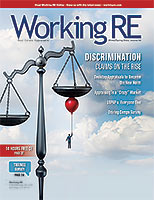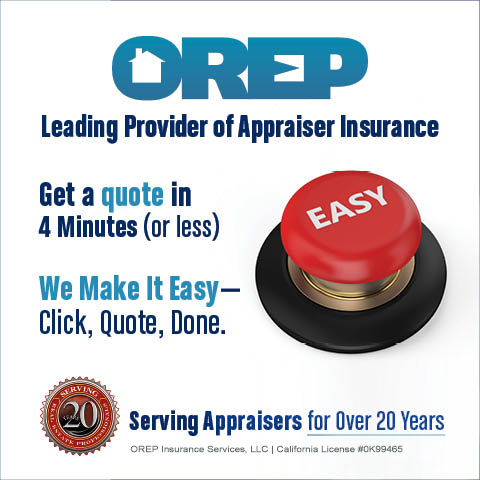 |
> OREP E&O |
Editor’s Note: Share your experience with trainees in Working RE’s Survey for Trainee Supervisors and help the entire industry. Take the four-minute survey now.
Insurance IQ: What is BIPD?
by Isaac Peck, Editor
In my role at OREP, I frequently have the opportunity to speak to appraisers about their risk management practices and answer questions that appraisers have about their insurance coverage.
I love talking to the boots-on-the-ground appraisers who are doing the work in the trenches—plus it helps me keep a finger on the pulse of the industry so I can continue writing relevant stories for you as Editor of Working RE.
One of the things that comes up repeatedly in my conversations with appraisers is what is the difference between E&O (Errors and Omissions) insurance and General Liability (GL), and along those lines: what is BIPD coverage?
First, here’s a quick definition of the first two:
- E&O Insurance: this is what most appraisers carry because lenders require it. E&O is malpractice insurance against errors or omissions made in reporting/professional services, such as using the wrong zoning, failing to report an easement or unpermitted improvements, measuring square footage incorrectly, or making other mistakes or oversights in your reports.
- General Liability Insurance: few appraisers carry this coverage. GL is carried by most retail establishments, as well as more “physical” professions such as contractors, plumbers, etc. The coverage can vary but it can cover your tools and it typically protects business against “slip and fall” lawsuits by providing Bodily Injury and Property Damage (BIPD) coverage.
Now keep in mind that these are two very large, but distinct categories of insurance. Many businesses only cover their business with one of these policies, while some carry both types of policies.
I don’t have any hard numbers, but if I had to guess I’d estimate that 97% (or more) appraisers are only carrying E&O insurance and do not purchase a separate GL policy every year. This means most appraisers do not have BIPD coverage unless it is specifically endorsed onto their E&O policy (more on this later).
That brings us full circle to our question: what is BIPD?
BIPD stands for Bodily Injury and Property Damage, and in the case of real estate appraisers, BIPD protects them for what E&O does not cover: accidental damage to property or persons (bodily injury) which you may cause while providing your professional services at an appraisal inspection.
One example is if you knock over a valuable vase (Grandma’s favorite 100-year-old vase, for instance) causing property damage or if you were to drop a flashlight (from the attic) breaking a homeowner’s toe (bodily injury). These types of claims are not very common but they happen.
(story continues below)
(story continues)
Some of the real-life examples of BIPD-related claims that we’ve seen here at OREP include:
- Insured exits the rear sliding door to measure the home but steps into newly poured cement that was just finished by the contractor several hours prior.
- Insured flushes the toilet and it overflows causing water damage to expensive flooring.
- Insured opens an attic hatch and (allegedly) causes damage to pop-corn ceiling.
- Insured steps through a ceiling during an attic inspection.
With FHA appraisals now requiring more and more from appraisers, including testing appliances, flushing toilets, and inspecting attics and crawl spaces, awareness about the need for BIPD coverage is increasing.
For this reason, more and more appraisers are purchasing General Liability (GL) policies, in addition to their E&O, that includes coverage for BIPD at the subject property. GL policies, which also can cover an appraiser’s own office in addition to coverage for inspection site, can range in cost from between $200-$500.
Good News
One bit of good news on this subject is that OREP’s flagship E&O program includes (at no additional cost) $100,000 of BIPD premises liability coverage (bodily injury/property damage). OREP insureds, in most states, now enjoy this valuable coverage at no charge when renewing their E&O insurance with OREP. This allows us to meet the needs of our OREP insureds while saving them money. Of course, if you have an office and want the additional coverage a GL policy can provide, we offer that too.
Most OREP appraisers also enjoy a zero deductible. In addition, OREP offers 14 hours of free online continuing education (CE) to all of its members (Approved in 46 states), which includes two valuable courses: FHA Appraisal Standards (7 Hours) and How to Raise Appraisal Quality and Minimize Risk (7 Hours). These courses are designed to improve your professional skills, lower your liability and help you protect your business. The benefit for our insureds is twofold—it makes them more careful, more successful appraisers and lets them keep a little more hard-earned money in their pockets, saving them over $200 in education costs.
Visit OREP.org for more and don’t forget to ask your agent about BIPD coverage. Stay safe out there.
Webinar: Introducing ANSI—New Requirements for Appraisers Fannie Mae started requiring appraisers to measure and calculate square footage using the ANSI system on April 1st, 2022—or appraisals will be rejected. Come learn quick and solid information that you need to do right away. Sign up now for our upcoming webinar, airing live on Thursday, April 28 at 10 a.m. Pacific Time.
About the Author
Isaac Peck is the Editor of Working RE magazine and the President of OREP, a leading provider of E&O insurance for real estate professionals. OREP serves over 10,000 appraisers with comprehensive E&O coverage, competitive rates, and 14 hours of CE at no charge for OREP Members (CE not approved in IL, MN, GA). Visit OREP.org to learn more. Reach Isaac at isaac@orep.org or (888) 347-5273. Calif Lic. #4116465.
Tips for Smoother Appraising
CE Online – 7 Hours (45 states)
How to Support and Prove Your Adjustments
Presented by: Richard Hagar, SRA
Must-know business practices for all appraisers working today. Ensure proper support for your adjustments. Making defensible adjustments is the first step in becoming a “Tier One” appraiser, who earns more, enjoys the best assignments and suffers fewer snags and callbacks. Up your game, avoid time-consuming callbacks and earn approved CE today!
Sign Up Now! $119 (7 Hrs)
OREP Members: Save 10%
>Opt-In to Working RE Newsletters
>Shop Appraiser Insurance
>Shop Real Estate Agent
Insurance
Send your story submission/idea to the Editor:
isaac@orep.org



